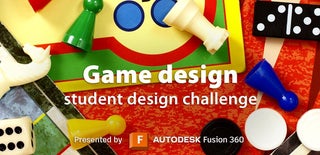Introduction: Mechanical Squid Game Bridge Game, Fusion 360 Design
I am a senior at Westlake high school in Utah, this fall I will be going to BYU to study mechanical engineering, and this is my take on the bridge from the TV show Squid Game. I thought the concept of the game was fun and wanted to make my own tabletop version that would be fun and simple to play but unlike the show, you can play without the risk of dying... This game uses a simple hinge design and magnets to operate. Each player takes turns setting the game and choosing which trap doors are safe and which are not by placing magnets or pegs. Then the other player who did not watch this happen moves the player pieces along. The player pieces have magnets on the bottom, if they are put on a tile with a magnet the door swings open dropping the piece down. I made two versions, a small-scale one that can be printed in place without supports and in one piece. The other one is a full-scale game that is printed in multiple pieces but still without supports. This was all designed in Fusion 360.
Supplies
A 3d printer (at least 220mm by 220mm build plate)
100 grams of filament for the full-scale game
50 grams or less for the small scale
6 x 2 mm neodymium magnets
Patience (the parts need to be printed at a high quality to ensure the doors operate smoothly)
No glue is required
Step 1: Making a Print in Place Hinge
I wanted to make sure that the hinge would be able to print in place and not require tedious assembly. Doing this required testing tolerances, and making the overhang angles no larger than 45 degrees. To create the hinge I used the revolve feature.
Step 2: Trap Door Mechanism
The next step was trying to figure out how to make certain trap doors open. The first picture is my first design. It was overly complicated and used a multi-directional hinge to operate, while it could still be printed in place it was way too complicated and would not be reliable. The open circle was for the magnet to sit in, and then a magnetic player piece would move it out of position making rotate down. This idea did not work. The second design is much simpler. It uses the magnet as the pin holding the tile up. You can see the small slots in the picture above. When the player piece is put in the center of the tile the magnet will move out of the slot causing the platform to fall. On platforms, you do not want to fall you can simply insert a non-magnetic tab. I then printed it out and it worked.
Step 3: Making the Full Assembly
Now that I had the hinge and the mechanism for the hinge designed, all that was left was to put it all together into a better package. This step took the longest because I experimented with different lengths, sizes, ways to assemble the game, and tolerances of the entire game. To create the first full version I simply patterned my previous design into a longer structure. Once this proved successful I realized that it did not match the show and so I changed it so the supporting beam went down the center instead of between every row. You can see this when comparing picture number two to 3. After this I made it look pretty and it was basically done. After this, though I decided to make a smaller-scale one that could be printed all in one piece, and would require less patience to print. This is the last picture. You can compare pictures four to five to see the difference.
Step 4: Making the Player Piece
This was the last step and the easiest. I used the revolve feature again to make the simple player piece. I made two styles, one where you could put two magnets inside(for a stronger pull to ensure better operation) and one with just one magnet. The magnets press fit in.
Step 5: Printing and Playing the Game
To print the game you will want to print it at a .12mm layer height for best results. You can do .2mm but .12mm is smoother. You will also need to make sure your printer bed is perfectly level. I printed the smaller version as shown above. I was in the process of printing the full-scale version but then the print failed in the middle and I did not have the time to print a new one. The small-scale one worked so the full-scale one should also. After printing it I did realize that some of the tolerances were slightly off and so I adjusted them for the files provided. Once you print everything simply put the magnets in the slots you want and challenge someone to play the game.
Print as many player pieces as you want
Print two of the Squid game bridge stair piece
Attachments

Participated in the
Game Design: Student Design Challenge
















